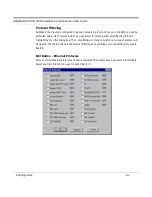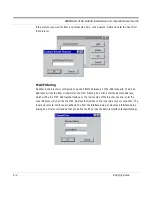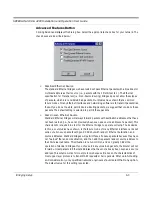
SPEEDLAN 4100 & 4200 Installation and Operation User Guide
Setting Up the IP Addresses (IP Host Setup)
7-5
Subnetting a Network
The increasing number of hosts and networks make impractical address blocks that are not smaller
than 245. In order keep the IP address small, so routers can manage them without changing the
whole protocol, a smaller network definition is created. This is called a subnet. Subnets are intended
to:
•
Reduce network traffic
•
Optimize performance
•
Simplify management
•
Create more effective and efficient addresses for large geographic distances
Default Subnet masks
•
Class A:
255
.0.0.0
•
Class B:
255.255
.0.0
•
Class C:
255.255.255
.0
Note:
Subnet mask is bolded.
What is a Subnet?
Subnetting allows you to create multiple networks within one Class A, B, or C network. Each data
link (octet) contains its own unique identifier also known as the subnet. Also, each node on the same
data link must belong on the same subnet as well.
What is a Subnet Mask?
A subnet mask allows you to mask section(s) (depending on the class specified) of the octets in the
network address. Each octet used in the subnet mask is assigned to a data link. The leftover octet(s)
are assigned to the remaining nodes.
For more information on subnetting, see the example below and
Diagram of Subnetting a Network,
.
Summary of Contents for SPEEDLAN 4100
Page 7: ...Chapter 1 Introduction...
Page 11: ...Chapter 2 Quick Start...
Page 21: ...Chapter 3 Hardware...
Page 25: ...Chapter 4 Overview of Configurator...
Page 31: ...Chapter 5 Configuring SPEEDLAN 4100 4200...
Page 43: ...Chapter 6 Bridging Setup...
Page 53: ...Chapter 7 Setting Up the IP Addresses IP Host Setup...
Page 67: ...Chapter 8 IP Router Setup...
Page 73: ...Chapter 9 SNMP Setup...
Page 77: ...Chapter 10 System Access Setup...
Page 79: ...Chapter 11 SNMP Monitoring...
Page 105: ...Chapter 12 Tables...
Page 115: ...Chapter 13 Analyzing Wireless Equipment...
Page 123: ...Glossary for Standard Data Communications...
















































